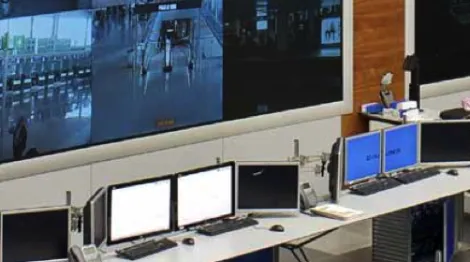The Future of Urban Sustainability – Summary of the Debate
The second plenary session on the cities of the future, held at the Smart City Expo 2013, included the participation of: Larry lye Hock – Urban Design Director – Urban Redevelopment Author...

The second plenary session on the cities of the future, held at the Smart City Expo 2013, included the participation of:
- Larry lye Hock – Urban Design Director – Urban Redevelopment Authority – Singapore.
- Sam adams – Executive Director – City Club of Portland – Portland – USA.
- Amitabh Kant – CEO & Managing Director – Delhi Mumbai Industrial Corridor Development Corporation -New Delhi – India.
- Sylvie Spalmacin-Roma – Vice President, Smarter Cities, Europe – IBM – Paris – France
- Nicholas Brooke – Chairman – Hong Kong Science & Technology Parks Corporation – Hong Kong – Hong Kong.
- Antonio Alfonso Avelló – International Department Director – FCC Environmental Services – Madrid – Spain
And it was moderated by: Cristiana Fragola – Regional Director, Europe – C40 – Milan – Italy
We leave you with some notes on the future of urban sustainability based on the debate that was generated in this plenary session.
Introduction of each speaker:
Larry lye Hock – Singapore.
Since 1965, Singapore has grown very rapidly, and with few resources and a lot of innovation, we have become one of the most free and developed cities in Asia, going from being a third world city to the first world in just one generation.
We have been able to carry out this development through alliances with public and private entities, and for this we implemented two major plans:
Concept Plan together with the United Nations, in which we identified the basic infrastructures and planned them 50 years in advance.
Master Plan 2008 – Which allowed us to plan the city according to its different densities.
Sam Adams – Portland
I am currently working for an NGO that develops civic innovation projects. But previously I participated in the management of the city and was able to verify the lack of coordination of the different government units we had and how inefficient they were.
This was the first challenge we faced a few years ago, and it was the reason for creating the Portland Plan. We involved the 25 administrative units, the private sector, and universities. This allowed us to know where we were and what the urban trends of the future were.
This Plan was developed over 2 years and was divided into 9 areas of action 25 years in advance, but broken down into 5-year phases. We included aspects of city, education, health… From these areas we planned the different levels of government and allowed us to improve the planning and habitability of the city.
Sylvie Spalmacin-Roma – IBM
IBM launched the Smart Cities initiative in 2008 as a major corporate commitment, but it became a market opportunity within a few years, as is happening.
The technology was mature enough to help the development of cities, and put it in the hands of political leaders.
We have been able to see the growth and acceleration of markets not only in developing countries but also in first world countries.
At the moment, public space is being reduced, and it no longer makes sense to continue growing with more infrastructure. The time has come for new innovative ways to continue advancing.
IBM’s Smart Cities is not only about a vision, but also about a market opportunity in which we have developed more than 1,000 pilot experiences, such as in Rio de Janeiro. IBM – Intelligent Operations Center is the star application that we have and develop for cities, however, it is necessary that together with technology, citizens and associations begin to internalize the potential of technologies for their city.
The city that manages to combine this data with collaboration and a new governance framework is what will make a city a Smart City.
Amitabh Kant – New Delhi.
India is experiencing exponential growth, which is leading to a new process of urbanization.
The territory is virgin and we must avoid reproducing the errors of developed countries. We must follow a model with a low carbon footprint.
For us it is very important that countries like India set the trends of the future, but the challenge is not in technology but in people, and in issues such as education, health…
Our Smart project is the first on a global scale of a global integration of the city, we work hand in hand with IBM, we bring together different entities with urban planning and development.
Technology must be at an accessible and sensible price, as happened with the penetration of the smartphone in our Indian market.
The important thing is not to repeat the mistakes that have occurred in the developed world.
Nicholas Brooke – Hong Kong
In 1997 we became a special region in China, we have a “soft” infrastructure that is currently sustainable, however, we have the same limitations as Singapore. Our population per square km is one of the highest on the planet.
Our challenges: we are a vertical community, density is a clear challenge, we want to address air quality problems, the other aspect is dealing with aging, it is interesting to see how we can allow people to age better.
As for China, we have major problems with access to housing and we are paying the consequences of disordered growth.
What has been built in the last 20 years has not respected the standards and we will have to reverse this situation, as well as face the problems of ownership. Finally, in Hong Kong before 1997 everyone was passing through, and we must develop that sense of belonging so that they get involved in the issues of the future.
Antonio Alfonso – FCC
We are leaders in the provision of intelligent services: waste management, water cycle. We work in urban development, and on many occasions we are the link between the citizen and the administration.
Our leadership is based on our experience and the innovation we carry out.
20 years ago we started developing the electric vehicle, and we have the largest fleet in Europe powered by gas and electricity.
Debate.
Cristiana Fragola – C40:We have a panel with speakers from different fields, I focus on the opinion of the cities and then with the companies. The lack of territory is a challenge for Singapore, but what other challenges do cities face?
Larry lye Hock – Singapore: the demographic increase implies a significant increase in pressure on existing infrastructures and access to resources such as water. We need more land to respond to current growth, we do it creatively, and we are committed to vertical growth upwards and downwards. We have opted for new water distribution and sanitation networks at great depth.
Sam Adams – Portland: Before ICT and Samrt Grids, intelligent networks must focus on intelligent management and communication. Another challenge is planning based on good information and incorporating all actors, not only specialists, but also social entities of the city. It is necessary to facilitate the participation of any person in the design of the city.
Amitabh Kant – New Delhi: the American urban development model is dead, the important thing in any city is urban planning. The second challenge is that the era of vertical planning is also dead, we must work on horizontal planning.
Nicholas Brooke – Hong Kong: Another challenge for cities is the increase in vehicles, cities in China have been designed around roads, with a weak public transport model. In terms of density, we have problems in the housing system, the accommodation plan is a challenge.
Sylvie Spalmacin-Roma – IBM: We are all talking about the same thing, offering better services to citizens, and they can live in the city if they have a good quality of life and a positive economic development.
Unfortunately and very often, innovation and technology are used by cities or regions to solve an extreme problem of urban viability.
The collection and management of data in real time is important. Data becomes another resource and serves to improve the efficiency of management. At IBM we say that data is the next natural resource. Cities are highly instrumentalized and we can collect data and manage it in an integral way.
Antonio Alfonso – FCC: the challenges are clear, but in mature cities we have other challenges to developing cities. However, there is a common challenge to all cities: economic and financial sustainability.
Although all the technology exists and is accessible, unfortunately it requires considerable investments, even from when it starts from scratch. There are two important issues for this sustainability, on the one hand, the legal framework must exist and facilitate private investment, to allow long-term disbursements. On the other hand, we must ensure that the external costs of Big-Data management are included in this equation. The economic model in the end is the key to the success of the city of the future.
Cristiana Fragola – C40: Another question, in the political agenda there is a consensus between the integration of urban planners, ICT and public employees. The Smart City must focus on this integration. ¿Could you add another variable to this integration in terms of the challenges of the city?
Larry lye Hock – Singapore: we have an important debate around the increase in population until 2030. We are planning in advance.
Sam Adams – Portland: it is also necessary to establish the objectives of the city you want to become, and on the other hand, public services are so important that any investment must bring new benefits.
Amitabh Kant – New Delhi: a political leader must have a vision of the future, and this vision must be technologically pioneering. But it is important to be aware that technology is not the ultimate solution. The challenge is to develop technological creativity, economic creativity, and artistic and cultural creativity.
Nicholas Brooke – Hong Kong: A sense of community belonging is needed. We work hard to sell the project to the community, so that they make it their own. We have to work hard to change the NIY Hong-kong mentality, and advance in public-private collaboration.
Sylvie Spalmacin-Roma – IBM: The citizen can also contribute in a very effective way with the technology available to obtain services from the city, that is, until now we were accustomed to the analysis of data from sensors, but now we all have smartphones with which we can send the city’s problems to the authorities, and we can create a response from the public authority. They are observational data. The other analysis that must be taken into account is the analytics in social networks, opinion is generated in positive and negative of a city issue, from IBM we are involving the public manager in approaching and understanding this communication in social networks. The combination of these three layers of data is a proposal for decision and action.
Regarding the terms of the business model from the private sector, many companies have had to transform themselves in order to continue with their business activity, reducing their costs. When transferring this management to the public space, we find examples in which the management of certain infrastructures becomes unaffordable, the incorporation of ICT can offer innovative solutions that can make these infrastructures profitable.
Antonio Alfonso – FCC: we must be transparent in the business models of investments in the city, and make known what the investments entail, the cost of the same and its viability in the long and medium term.






